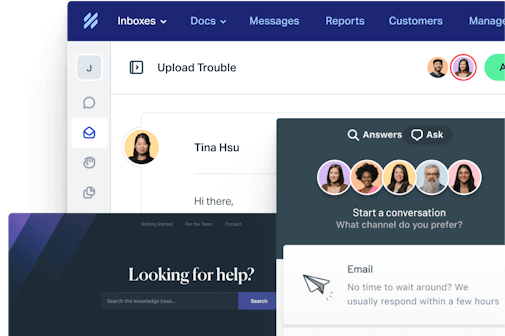Some would argue that chasing “stretch goals” may do more harm than good — after all, what happens when we don’t hit them?
It can be demoralizing for teams to run after goals with everything they’ve got, only to fall short. And what happens to the leaders of those teams — do they get shown the door? (In some companies, yes.) Risk-averse organizations, writes David Ciccarelli for , would “rather hit a modest goal and appear successful than fall short of a wildly ambitious stretch goal.” And some leaders eschew a goal-oriented mindset altogether.
At Help Scout, we make a habit of setting audacious goals, fully aware that there’s a good chance we won’t hit them. Back in 2015, for example, we set out to triple our revenue. We rallied around the “3x” plan although we knew it was ambitiously high, and everyone in the organization rowed in that direction.
3 reasons to set big goals (other than to try to achieve them)
There’s value in going after big goals beyond achieving them, and in our experience, the payoff — even when we miss by a mile — is worth the risk. Here’s why we set aggressively large goals.
1. Big goals stretch what we believe is possible
When we set a big goal, we build a bottom-up plan to achieve it. Goals like “3x” not only align and focus a group of people, they force us to get creative and place bets we may not have otherwise considered, because going with the status quo won’t get us nearly as far.
That’s the idea behind BHAGs — Big Hairy Audacious Goals, the term Jim Collins and Jerry Porras coined in Built to Last to describe wildly ambitious, if not impossible, organizational goals. (Microsoft’s “A computer on every desk and in every home” is one.)
“The power of the BHAG is that it gets you out of thinking too small,” Collins told Inc. “In the end, the purpose of a BHAG is to make your organization better. It forces you to dramatically improve because otherwise you won’t be able to achieve it. It’s a mechanism to stimulate progress.”
We’ve tried a number of experiments — resulting in some wins and some losses — that we probably wouldn’t have tried had we not set an ambitious goal that pushed us toward taking the risk. As a result, we started thinking bigger and improved the overall trajectory of the business.
2. Big goals force us to test and learn quickly
Setting big goals forces us to try out a number of hypotheses and experiments, and to make some mistakes — all of which exist because we’re pushing ourselves to meet an incredibly ambitious goal.
One mistake we made in going after the 3x goal was overestimating what we could accomplish through paid advertising. We expected customer acquisition to increase somewhat linearly as we spent more, but that correlation broke way sooner than we expected. This insight has shaped our paid advertising strategy since, and it’s forced us to get creative in other areas, but we wouldn’t have discovered it without a big goal.
3. We’re at our best when the work is hard
We’re big believers in forced constraints. Constraints like deadlines and OKRs (used sparingly, to avoid burnout) force us to approach challenges from different angles. As our CEO Nick Francis put it in Keeping Our Overachiever Culture:
Self-imposed limitations can unlock magic when applied properly to a team, a product, or the business as a whole … constraints help you focus on what’s most important and bring out your best work.
My team, for instance, is currently tasked with growing our email subscriber list by a factor of about five. I’ll admit — it’s a little terrifying. But darn if it isn’t inspiring some creative, innovative thinking.
(Oh, and did we 3x the business? No, but we did more than double our business that year — a feat we may not have otherwise achieved had we not set our sights as high.)
It’s OK to swing and miss
We talk about this as a team a lot. If leadership were opaque about the rationale behind setting big goals, they’d risk demoralizing the team when we fell short. But the truth is:
If there’s not a decent chance you’ll fall short, you’re not setting high enough goals.
Google, who uses an OKR scale of 0-1, tells teams to aim for 0.6-0.7 — if you achieve a 1 on your key result, then you went too easy on yourself. Likewise, Collins says a 50-70 percent chance of achieving your BHAG is ideal.
We set big goals not to hold anyone’s feet to the fire, but to learn as much as we can along the way and to force creative and innovative thinking. It’s OK to swing and miss, and there’s no reason to be disappointed when we do. We still want to reward the aspiration and the good faith effort. When we don’t meet a goal, we just take the opportunity to be honest about what happened — did we set the right goal? Did someone not deliver? Did leadership create the right environment, resources and motivation for the goal to be achieved? — and learn from it as quickly as we can before moving on.
We’re lucky to have a board who supports that, because they want us to achieve our potential. They don’t benefit when we play it safe, and they understand that if we’re not pushing the limits, someone else will.
… As long as you hire the right people
If we’re not holding anyone’s feet to the fire, that begs the question — what’s the motivation for working hard to achieve these goals when we know we’re not going to experience any negative consequences?
The answer is to hire intrinsically motivated people who want to make an impact. “If someone isn’t motivated by a desire to do great work and build a great business, they probably shouldn’t work here,” Nick says. “I’d like to think our people don’t need to be threatened to put themselves in a position to do their best work. I’m not going to attempt to motivate anyone based on fear.”
Most people will overachieve if they know the business is counting on them to do so. Given the right amount of trust and ownership, everyone on the team can and should be able to maximize their net productive output.
Chief Growth Officer Suneet Bhatt puts it another way: “If we had missed those goals and I’d been fired, would anyone want to set another big goal ever again?”
This goes for you, too
Most of us can use the reminder to set far hairier goals than what we first assume we’re capable of achieving. It’s a worthwhile practice, and I’d encourage anyone to to examine whether they’re selling themselves short. I know I’m guilty of getting caught up in the day-to-day, and I sometimes forget to take a step back and think about what I could accomplish if I dreamed big enough to begin with.




